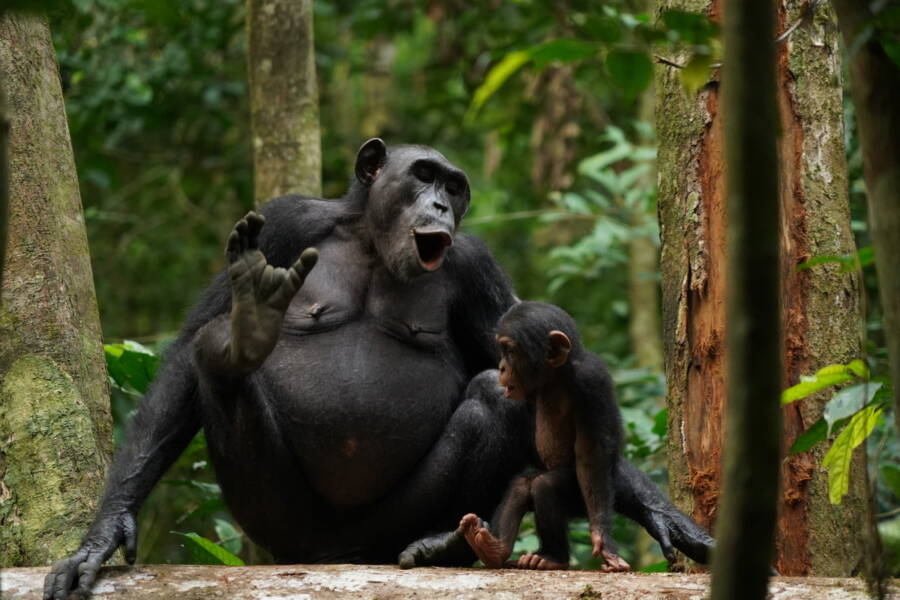The study found that chimps have syntax and produce specific sounds to express meaning. The study may shed light onto the evolutionary history of human language.

Liran Samuni, Taï Chimpanzee ProjectA mother chimp vocalizing with her young.
When something goes wrong, a human being can use words, expressions, and sounds to convey danger. A simple shout of “Oh no!” “Help!” and “Watch out!” coupled with gestures and concerned facial expressions is more than enough to alert other human beings to a possible threat.
Researchers from the University of Zurich wanted to know if chimpanzees, some of humankind’s closest living relatives, are also capable of this level of communication. Now, their research has found that wild chimpanzees in Uganda may have their own primitive language, complete with syntax.
In the study, which published in Nature, scientists employed the use of fake snakes strung on fishing lines to observe and record the chimpanzees’ reactions to these “snakes.” Then, the researchers played back the sounds in different orders to see which one, if any, elicited a stronger response.
What the team found was that the chimpanzees not only had specific sounds with corresponding meanings but that they also understood word order and reacted accordingly depending on which sound came first in a sequence.
Researchers noticed that the chimps produced two distinct sounds at the sight of snakes and other dangers in the wild: “waa-barks,” or calls for other chimps to help, and “alarm-huus,” or calls to alert to potential danger.
In the first phase of their fake snake prank, the team placed fake snakes near chimps and recorded their reactions.
Then, they moved on to a playback test. As they reeled the fake snake through the Ugandan jungle, they played recordings of both the “waa-barks” and “alarm-huus” in different patterns, sometimes solo and sometimes in varying sound combinations. Sometimes the team would play the “waa-barks” first in a sequence, other times the “alarm-huus.”
What they found was that the chimps reacted stronger when a “waa-bark” was followed by an “alarm-huus,” suggesting that the sound order played a role in the chimps’ response. Researchers say this points to the existence of syntax in the chimp’s primitive language.
“We propose the ‘alarm-huu + waa-bark’ represents a compositional syntactic-like structure, where the meaning of the call combination is derived from the meaning of its parts,” the team explained in their study.
These findings are not only significant for understanding chimpanzees but also the evolutionary history of mankind.
The researchers say that chimpanzees using syntax in their language shows that it did not originate within human beings, “but that the cognitive building-blocks facilitating syntax may have been present in our last common ancestor with chimpanzees.”
“Humans and chimpanzees last shared a common ancestor approximately 6 million years ago. Our data therefore indicate that the capacity to combine meaningful vocalizations is potentially at least 6 million years old, if not older,” study author and University of Zurich professor Simon Townsend said in a release on EurekAlert.
This study is yet another addition to the exciting new research coming out about the great apes’ use of language.
Just last year, another study showed that chimpanzees in Côte d’Ivoire understood over 390 unique vocalizations, as reported by Salon. Further testing showed that the chimps may be able to use these vocalizations to create new distinctive words.
“From a purely structural perspective, the capacity to organize single units into structured sequences offers a versatile system potentially suitable for expansive meaning generation. Further research must show to what extent these structural sequences signal predictable meanings,” one study author wrote at the time.
Hopefully, future research will allow us to better understand the language of our closest relatives and put the pieces of our own linguistic evolution together in the process.
After learning about the language of chimpanzees, read about Ham the Chimp, the first chimpanzee in space. Then, uncover the story of how studying chimps led researchers to find out humans may have walked on two legs while still swinging from trees.





